Jaeger-LeCoultre Reverso Gyrotourbillon 2 Reviewed by Tim Mosso: Sheer Spectacle!
by Tim Mosso
The 2004 Jaeger-LeCoultre Gyrotourbillon wasn’t the first wristwatch to feature a tourbillon with more than one axis, but the totality of its innovation was staggering.
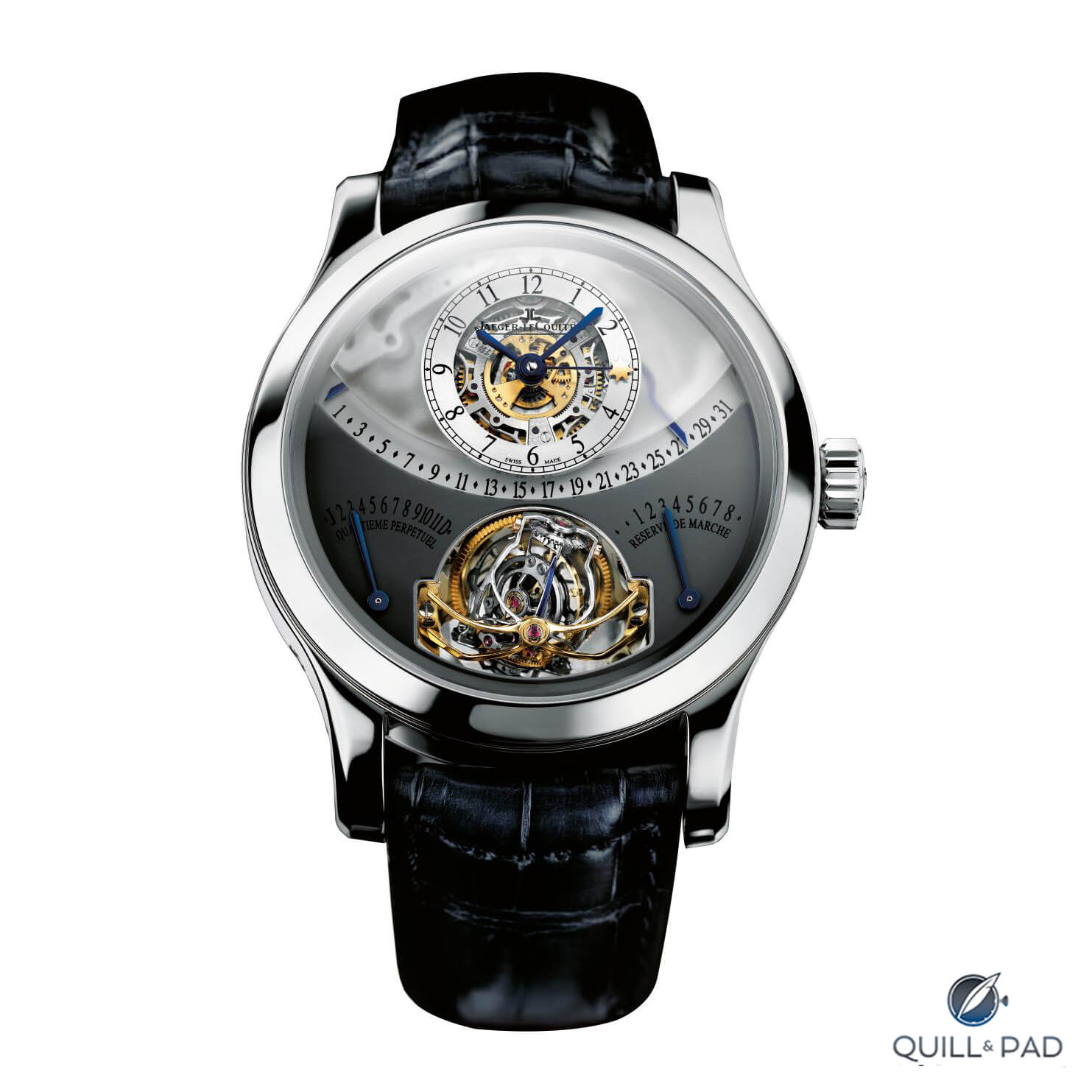
Jaeger-LeCoultre Gyrotourbillon 1
Engineered by tourbillon savant Eric Coudray, the Gyro rocketed to GPHG recognition and collector esteem. It had only one problem: an anonymous shape.
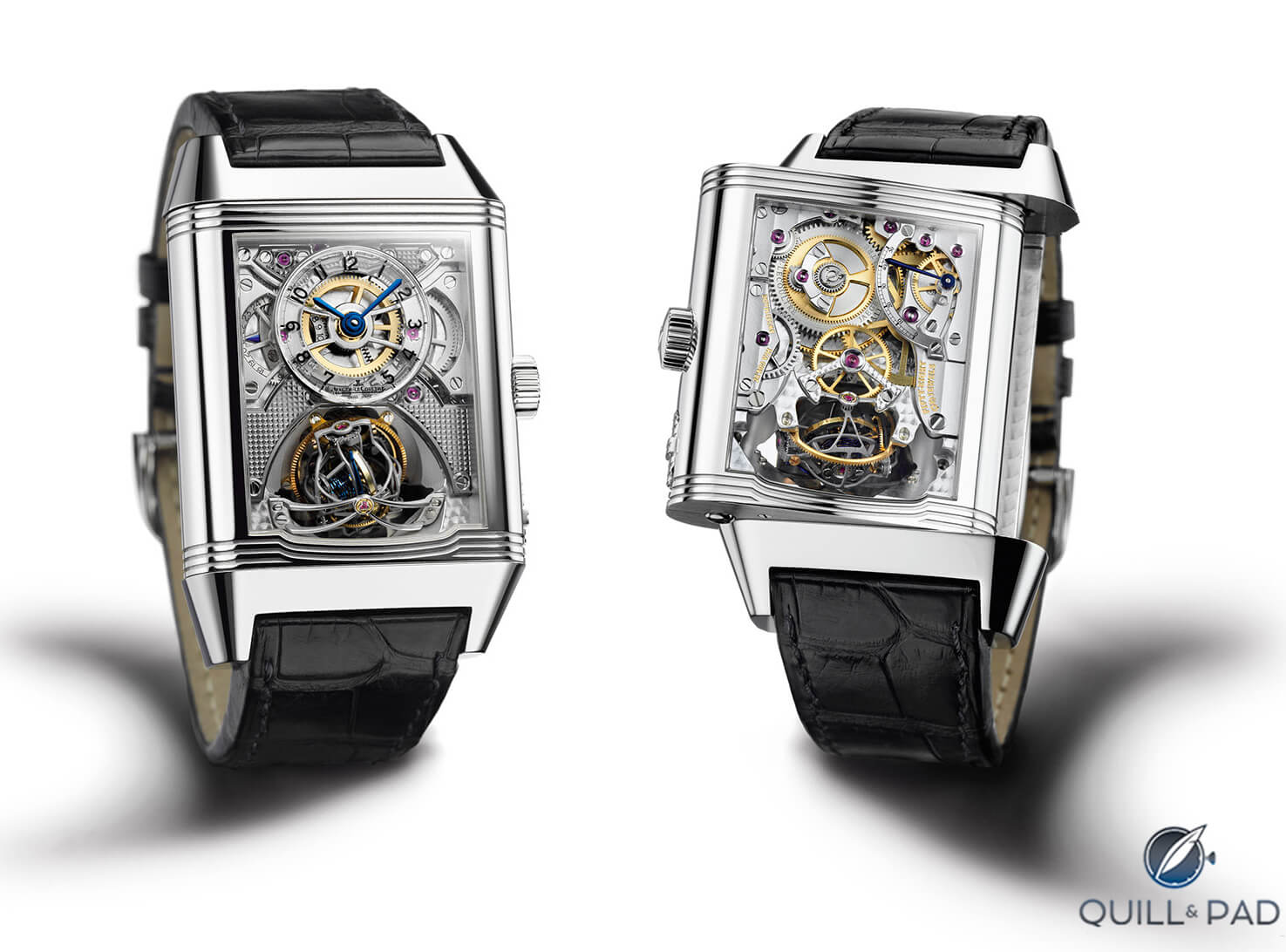
Jaeger-LeCoultre Reverso Gyrotourbillon 2 in platinum
Cue the 2008 Reverso Gyrotourbillon 2. Supercharged by JLC’s iconic reversible case, the Gyro 2 left nothing on the table. For wrists of tectonic scale, the king of Reversos was the full package.
JLC’s Reverso went on a linebacker meal plan during the 2000s. Granted, it was a period of elephantiasis for the industry in general, but the Reverso ramped up faster than most.

Wrist shot of the Jaeger-LeCoultre Reverso Squadra (photo courtesy Miguel Seabra)
The “big” Reverso of the 1990s, the grande taille, became almost quaint amid the “XGT” sized seventieth anniversary Reverso of 2002, the square-cased “Squadra” line of 2006, and that year’s triple-dial Grande Complication à Triptyque.

An open view of the Jaeger LeCoultre Reverso Grande Complication à Triptyque
The last was so large that a sliding “case lock” was implemented to keep its dirigible-scale platinum inner case from departing the fixed position.
More than any other ancestor, the Gyrotourbillon 2 is the direct descendant of the Triptyque. The scale, mass, and sheer presence of the two machines feel as epic as any two sister ships since the Titanic and Olympic cohabitated Harland and Wolff shipyards in Belfast.
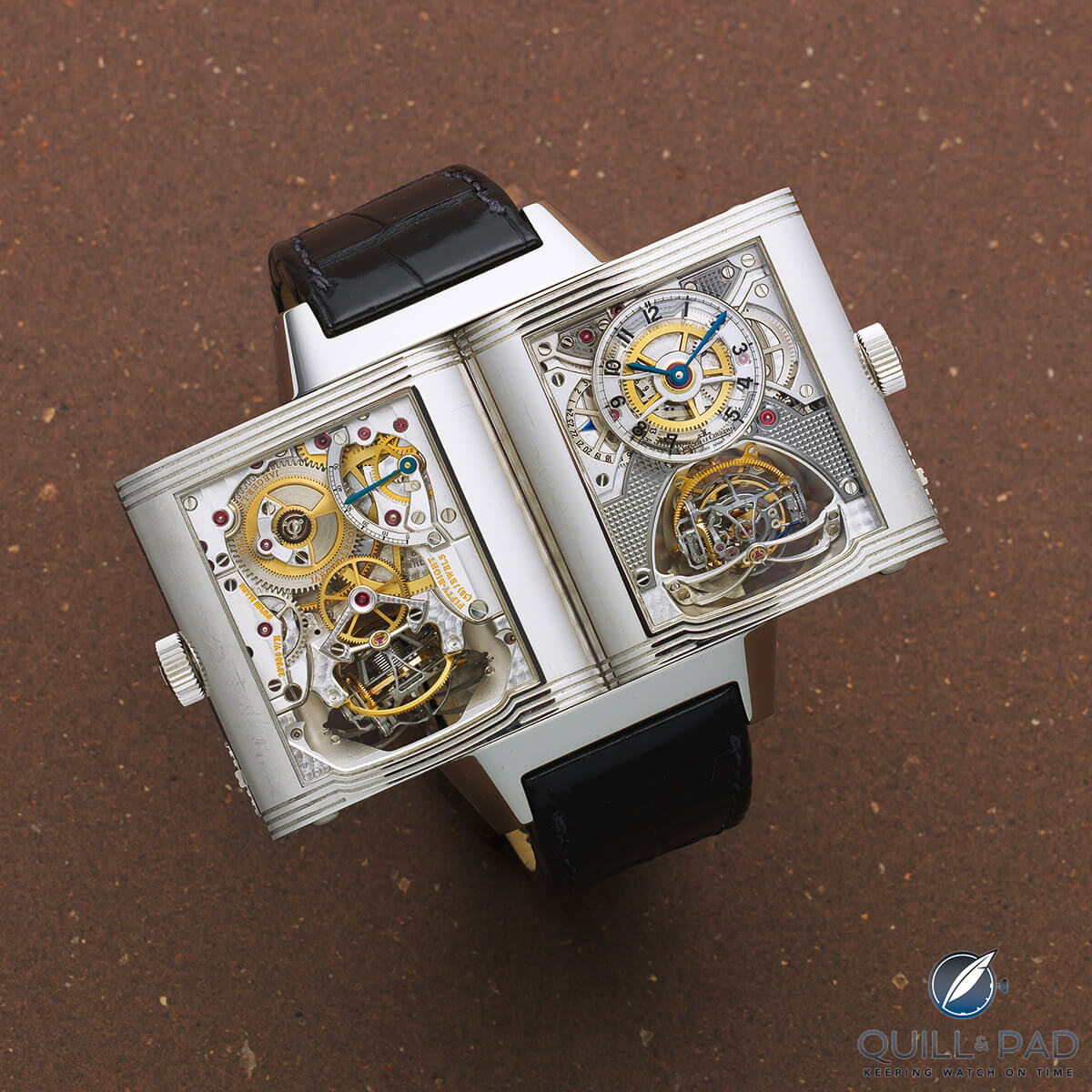
Jaeger-LeCoultre Gyrotourbillon 2 (photo courtesy www.bonhams.com)
Better fortune befell the Gyrotourbillon 2, and it offers a case study in what Jaeger-LeCoultre can accomplish with a cost-no-object development brief.
Platinum was employed for this pivoted case because of course it was; excess was the point back then, and 2008 was the peak before the fall. Due to the sheer weight, the Gyro 2 reprised the Triptyque’s case lock trigger. While a small amount of play is perceptible, the lock keeps the big watch from flying open at inopportune times. Spring-loaded ball bearing pin snaps emit a satisfying “snick” as the case moves into and out of its guide tracks.

Opening the Jaeger-LeCoultre Reverso Gyrotourbillon 2
Like all Reversos, a properly assembled Gyro 2 feels crisp, precise, and premium as it transitions between sides.
The 1980s witnessed the re-emergence of the Reverso as a model line, but it was clear by the early 90s that the watch’s alleged sports watch roots (I’m skeptical) had eroded entirely. By then a true dress watch, the Reverso was reinvented as a double-sided showcase for visible movements, complications, or both.

Jaeger-LeCoultre Reverso Gyrotourbillon 2
The Gyrotourbillon 2 tells time with it’s a simple two-hand display flanked by a separate 24-hour scale; it’s not a second time zone. That said, the hook isn’t the time at all; it’s the presentation.
JLC mounts the hands on a skeletonized flying bridge beneath a sapphire dial ring. The bridge is full of sharp interior-crevice anglage the company generally omits even on flagship models. Flanking movement plates feature blindingly bright rhodium-plated pyramide hobnail guilloche that’s superbly superfluous and creates a suitable sense of occasion for the show-stopping tourbillon.

Titanium cages of the multi-axis tourbillon of the Jaeger-LeCoultre Reverso Gyrotourbillon 2
Suspended on a lace-like bridge, the tourbillon is a titanium construction with two axial circuits. The first is a conventional one-minute rotation, but the second is a manic 18.75-second flutter that’s almost disorienting to behold and might rival 1990s anime for epileptic seizure risk.
Even compared to the 2004 Gyrotourbillon, the Gyro 2 is a furious thing. While the original watch featured a 24-second inner tourbillon and a 3Hz beat rate, JLC stepped up the rate to 4Hz and accepted a lower power reserve to supercharge the sequel.
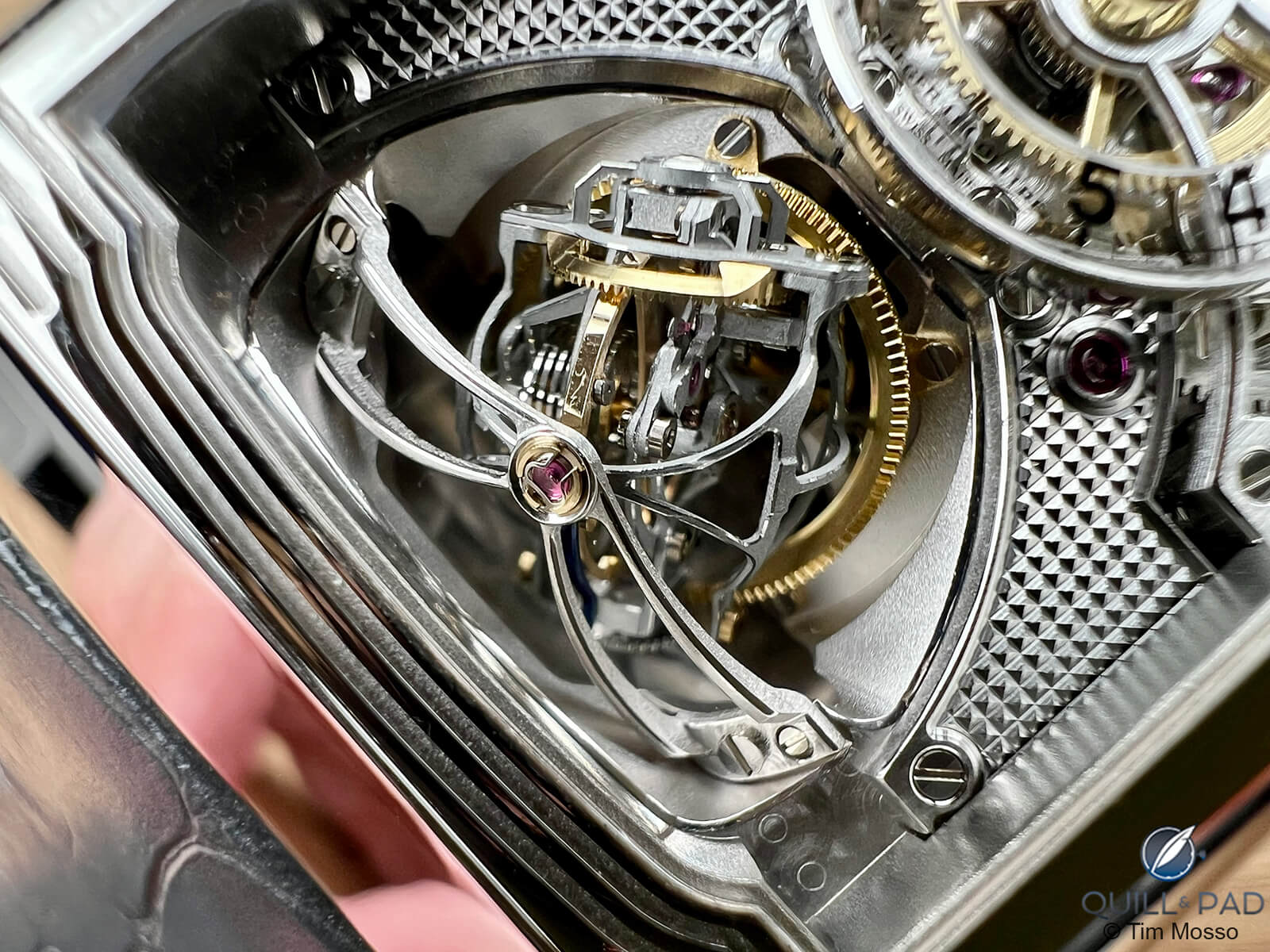
Multi-axis tourbillon of the Jaeger-LeCoultre Reverso Gyrotourbillon 2
The titanium construction and web of miniscule cage frames were a challenge to decorate, but JLC appears to have achieved a sufficient, if not virtuosic, combination of media blasting and thin bevels on these surfaces.
JLC also took a page from the Greubel Forsey playbook and strategically angled the outer tourbillon in hopes of gaining a bit more advantage against the ravages of gravity when the watch sits static at night. All other times of day, the caliber 174 relies on its battery of different orientations to cancel out the effect of Higgs’ boson on timing precision.

Cylindrical hairsping inside the multi-axis tourbillon of the Jaeger-LeCoultre Reverso Gyrotourbillon 2
A cylindrical hairspring – thank you, John Arnold – is provided to further the watch’s prospects against Earth’s pull. Intriguingly, both inner and outer tourbillon cages are suspended by shock protection springs. It’s an uncommon refinement on any tourbillon much less one that’s twinned.
The effect of the springs may be less about preservation against shock than it is about keeping the balance staff centered in its jewel cups. Whether all these chronometric considerations pay off is a matter of perspective.
In the 2009 Concours International de Chronométrie, JLC tourbillon regulators took first and second places against a battery of elite opponents. Unfortunately for Gyro 2 fans, it was the steel-cased $50,000 Master Tourbillon that won gold with the Gyro 2 taking silver.
But – and it’s a big but – static tests of wristwatch tourbillons include four positions out of six where the tourbillon rotates on an axis perpendicular to the force of gravity.
This absolutely doesn’t happen on the wrist, but it allows a carefully regulated single-axis tourbillon to run up the score against multi-axis versions under lab conditions. On the randomly flailing human wrist, the compound version of the tourbillon likely closes or erases the gap entirely.
The Reverso Gyrotourbillon 2 retains the watch’s original circa 1931 parlor trick, and the rotating case is put to good use. Its verso side doesn’t include any time displays, but the lower bridge of the tourbillon offers another vantage point from which to appreciate the machine.

Movement side of the Jaeger-LeCoultre Reverso Gyrotourbillon 2
Additional backside refinements include a power reserve indicator and a barrel equipped with an elaborate stopworks.
The stopworks guards against over-winding the mainspring at the high end and time loss at the low end. Because watchmakers understand that a stopped watch is easier to recognize than one losing time, the low-energy stoppage is a failsafe of sorts. Due to the residual energy in the stopped barrel, even the slightest winding of the crown causes the stalled movement to start instantly.

Movement side of the Jaeger-LeCoultre Reverso Gyrotourbillon 2
It’s important to make a quick note about the standard of finish on this watch. Jaeger-LeCoultre watches priced for the mainstream market primarily include machine-laid decoration.
Only above the CHF 100,000 does the JLC standard of finish begin to rival haute horlogerie executions from other brands.
On the Gyro 2, broad mirrored bevels speak to the extra time invested. The lower bridge for the tourbillon includes rounded and polished braces comparable to Greuble Forsey and De Bethune executions.
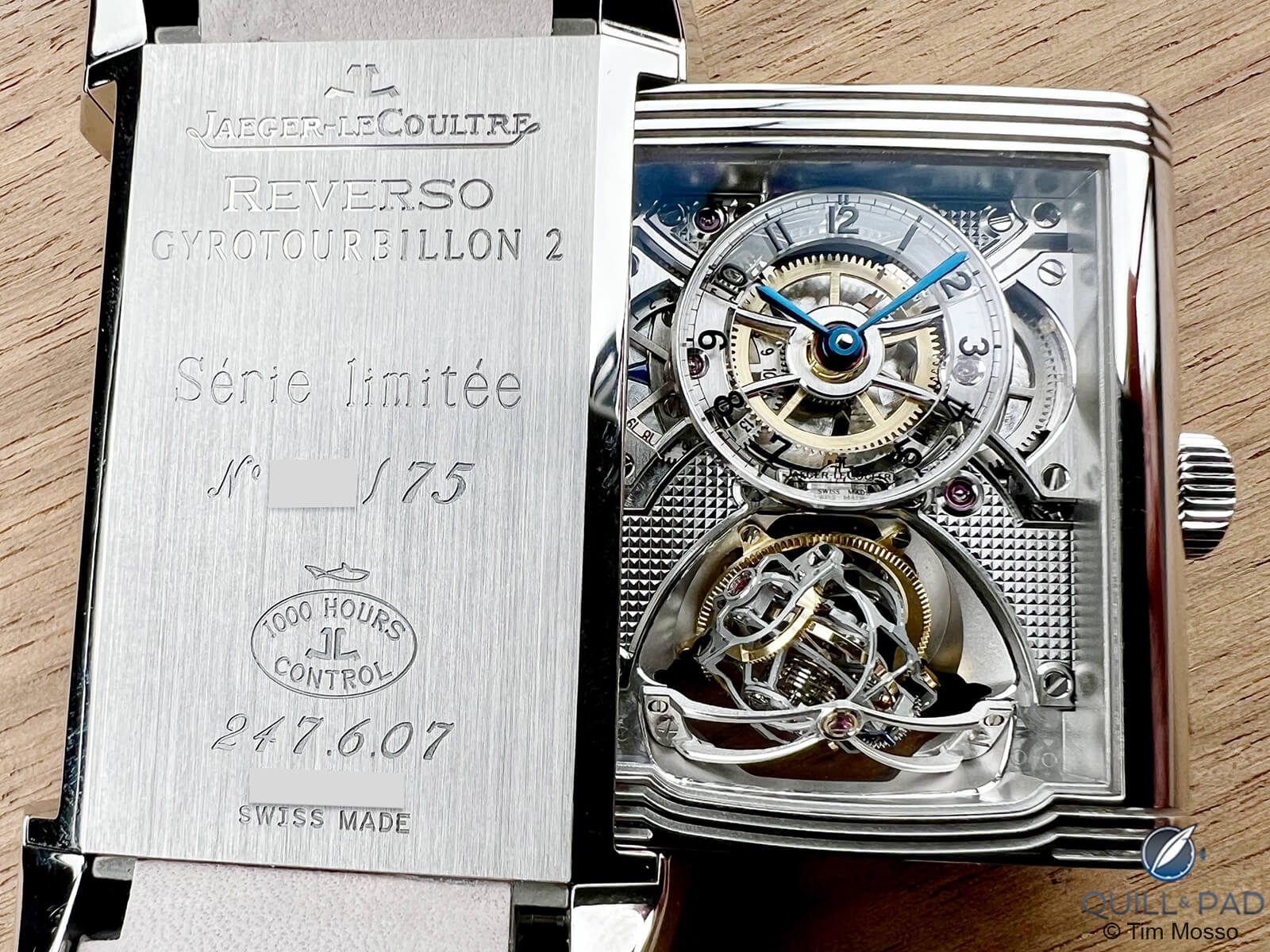
Jaeger-LeCoultre Reverso Gyrotourbillon 2
Flanks of the sapphire dial’s underlying bridge are brushed with straight graining in a vertical orientation. The reverse side includes bridges with a combination of engine turning and stripes. Ratchet wheel teeth exhibit polishing, and that’s a measure taken on vanishingly few watches to hail from La Grande Maison.

Movement side of the Jaeger-LeCoultre Reverso Gyrotourbillon 2
Despite the company’s near universal use of heat-blued screws on its mainstream models, Jaeger-LeCoultre opted to use only mirror-finished examples in order to maintain the cool monotone swagger of this watch. In short, JLC put in the work to ensure the watch’s refinement lives up to its engineering.
There are guitar collectors who don’t play, race car collectors who don’t hit the track, and connoisseurs of gems who wear none. No watch of the Gyro 2’s size and price is designed with a view to daily use. But, for many collectors, a platinum brick like the Reverso Gyrotourbillon is more of an object d’art.

Jaeger-LeCoultre Reverso Gyrotourbillon 2
Judged on the basis of sheer spectacle, it delivers. It’s absolutely the case that such a watch could be owned, appreciated, and shown with pride at a Red Bar meetup while never riding a wrist. Whether presented in the hand or on the arm, the Gyro 2 is an event.
For more information, please visit www.jaeger-lecoultre.com/us-en/our-maison/masters-of-complications/multi-axis-tourbillon
Quick Facts: Jaeger-LeCoultre Reverso Gyrotourbillon 2
Reference Code: Q2336420
Functions: Hours; minutes; power reserve indicator; 24-hour indicator
Case: Platinum; 36mm diameter; 16.5mm thick; 55.3mm lug-to-lug; 23mm between lug horns; reversible case with sliding case lock mechanism; 30 meters of water resistance
Dial: Recto dial: open wrought with hobnail movement elements, hours and minutes with sapphire scale, 24-hour dial, bi-axial tourbillon. Verso dial: power reserve indicator, bi-axial tourbillon
Movement: Caliber 174; manual wind; 50-hour power reserve; 4Hz beat rate; 58 jewels; free sprung balance; bi-axial tourbillon with 18.75 and 60-second circuits; cylindrical hairspring; power reserve indicator, stopworks for barrel; 24-hour indicator, Master 1,000 Hours tested
Strap: Rectangular scale blue alligator leather top with small round scale grey alligator leather lining
Clasp: White gold deployant clasp buckle with double folding action
Limitation: Launched in 2008 in 75 pieces
2024 Preowned Price: $110,000-$119,000
* Tim Mosso is the media director and watch specialist at The 1916 Company. You can check out their very comprehensive YouTube channel at www.youtube.com/@the1916company.
You might also enjoy:
Jaeger-LeCoultre Watches: Why Are They Not More Popular?
Why I Love the Jaeger-LeCoultre Reverso – and You Should Too
Jaeger-LeCoultre Master Compressor Memovox Reviewed by Tim Mosso



Leave a Reply
Want to join the discussion?Feel free to contribute!